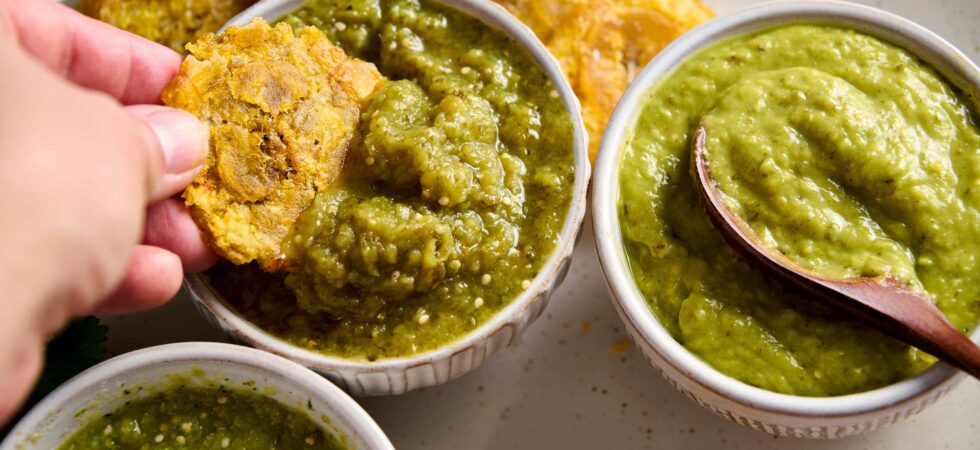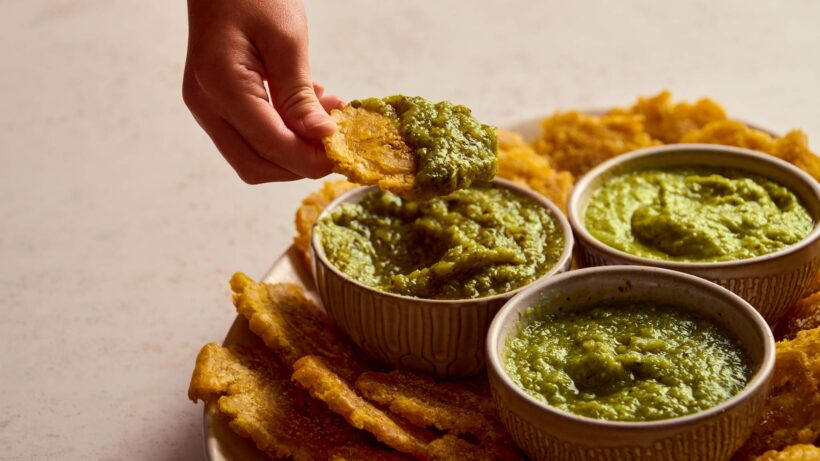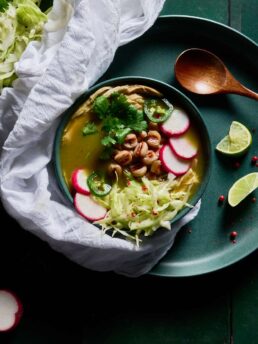Salsa Verde: Tomatillo Salsa (4-ways)

Salsa Verde is a classic Mexican salsa made with cooked tomatillos. This recipe roasts them in the oven. Though, you can also boil them or char them on a grill (see FAQs). Add fresh onion, garlic, lime juice, cilantro, and spices for a refreshing, acidic and sometimes spicy dip/topping. It’s an absolute staple at my house, especially during the summer, when tomatillos are in season.
And when one tomatillo salsa isn’t enough, you make multiple variations and share your knowledge with others!
This recipe makes a traditional salsa verde and then strays from tradition with the addition of poblano peppers and/or avocado, for 4 possible but distinct salsas. Simply add the ingredients from either (or both) of the secondary recipes to make a new salsa. This recipe also includes a few optional instructions to enhance the texture and flavor of your salsa verde, but you can skip them on lazy days.

Get the Recipe: Salsa Verde: Tomatillo Salsa (4-ways)
Ingredients
Traditional Salsa Verde
- 10 medium tomatillos
- 1-2 jalapeño(s) or serranos
- 1 tablespoon neutral oil
- ¼ teaspoon black peppercorns
- ¼ teaspoon ground coriander seeds
- ¼ teaspoon cumin seeds
- ½ teaspoon Diamond Crystal kosher salt
- ⅓ bunch cilantro, (middle of the bunch soft stems and some leaves)
- 2-3 cloves fresh garlic
- 1 white onion
- 1 tablespoon fresh lime juice, (additional to taste)
Roasted Poblano Salsa Verde
- 3 poblano peppers
Guac-Verde (Salsa Verde con Aguacate)
- 2 avocados
- ¼-½ teaspoon Diamond Crystal kosher salt
- 1 tablespoon fresh lime juice
Equipment
- kitchen scale (optional)
- 1 cutting board
- 1 chef knife
- Measuring spoons
- 1 baking sheet
- tongs
- medium bowl or plastic baggie (optional)
- cling wrap (optional)
- measuring Cups (optional)
- 1 Small Sauce Pot (optional)
- 1 tool for scraping up fond (optional)
- food processor or blender
Instructions
- First, turn on your oven to 425°F (218°C) with a sheet pan inside. Let it come to temp and get everything nice and hot for at least 30 minutes.
- While the oven and pan are heating up, clean your tomatillos by removing their husks and washing off the stickiness. Slice the jalapeno(s) or serrano(s) down the center and remove the seeds depending on how spicy you'd like the resulting salsa. If making the poblano version, slice the poblano peppers in half and remove their seeds as well. Put the tomatillos and peppers into a medium-large bowl and drizzle with oil. Toss everything to coat. Set aside until ready to cook in the oven.
- Next, take out your blender and set it aside on the counter with the lid off. If you want to toast your spices (optional), now's the time. Bring a stainless-steel pan to medium heat on your stove top and add the black peppercorns, coriander, and cumin. Move the spices around the pot by shifting it back and forth every 30 seconds or so. Once you can smell the spices, take them off the burner and dump them into your open blender. (See notes)
- Add in salt and the middle ⅓ of your cilantro bunch as well as the fresh garlic cloves, rough chopped onion, and lime juice.
- Your oven and pan should be properly pre-heated by now. Carefully pull the pan out of the oven and add the prepped peppers and tomatillos onto it. Place it back into the oven and let them roast for 10-15 minutes. Then, turn your oven to broil and let them char for another 2-5 minutes, until the skin on the peppers starts to blister and turn black.
- Take the roasted ingredients out of the oven and use tongs to add the tomatillos to the blender. Don't worry if your tomatillos have broken open, we will get to that in a bit. If you want to peel your peppers (also optional, see FAQS for an explanation) place the peppers in a medium bowl and cover it with plastic wrap for 5 minutes.
- While the peppers steam, deglaze the roasting pan. Add ¼-⅓ c (60-80ml) water to a small sauce pot and bring it to a boil. Then, pour the water over the browned sections or fond (e.g. tomatillo guts) on the pan. Make sure the pan is cool enough to handle before the next step or use a towel/mitt. Using a spoon, bench scraper, or spatula with a flat edge dissolve and scrape up the fond until the water has turned brown and collected all of the flavor. Pour the pan drippings into the blender.
- Next, remove the plastic wrap over the pepper bowl and peel off as much of the pepper skin as possible. Add the peeled peppers to the blender and blend everything together to your desired consistency. If you want to make the third version of salsa verde with avocado, this is where they get added. Slice them in half, remove the pit, and scoop the avocado meat out with a spoon into the blender. Stop when the salsa becomes uniform and creamy. Enjoy!
Notes
- Don’t worry if you don’t want to toast or use whole spices. Just make sure you flavor to your tastes. If you use pre-ground spices, for example, you might need more of each than the recipes lists. For reference, from less to most flavorful it goes, pre-ground < whole, freshly ground < toasted & whole, freshly ground.
- My spices are ground when I blend everything in my high-powered blender. If you use an immersion (stick) blender or a food processor, consider blending the spices in a spice or coffee grinder or mortar and pestle after toasting them (before blending into the salsa).
- If you can’t find poblano peppers, Anaheim or cubanelle peppers will work too. (Of note: the flavor will be a little different, more acidic and less vegetal)
- To help choose between jalapeño and serrano peppers decide on what spice level you’d like in your salsa, jalapeños are mild and serranos are medium.
- Notice which part of the cilantro I use. Typically, I use leaves for garnish, middle (softer) stems and leaves for salsas, and the bottom (harder) stems for stocks.
Nutrition
Nutrition with Poblano Peppers

Nutrition with Avocado

Nutrition with Avocado and Poblano Peppers


Frequently Asked Questions
Yes. Besides roasting in the oven, you can also use one of these three methods:
1. Stove top (sauté): Using a medium sauce pot or deep saucepan (no anodized non-stick surfaces), turn the burner to med-high/high heat and let the pan get hot. The pan is ready when you can flick water over its surface, and it skitters around instead of immediately evaporating or bubbling in place. This means the pan has heated enough that its atoms have expanded and filled in any gaps that make food stick. You are essentially turning your stainless steel or carbon steel pans non-stick. Add the tomatillos, jalapeño(s) and poblano to the hot pan and let them sear. After you get some good, charred spots, turn the heat to low and cover with a lid. Let this cook until the peppers and the tomatillos soften and them add them to a blender with the other ingredients (option to rest and peel the peppers).
2. Stove top (boil): I’ve seen a number of recipes that fill a pot with water and boil the tomatillos and cut peppers. Keep in mind, it’s definitely the fastest way to cook them but will also be the least flavorful of these three cooking options. To make salsa verde this way, heat water in a pot to a very gentle simmer and drop in your tomatillos and peppers. Let them cook until the tomatillos dull and turn a tan color. Make sure to keep an eye on them, if tomatillos cook too long, they burst open, and you will lose a lot of the cooked flesh to your pot water. Once cooked, add them to the blender with the other ingredients (option to give the peppers and ice bath and peel them).
3. Grill: Using a medium-high heat, tomatillos and cut peppers directly on the grill grates. Then lower the heat and close the cover. Let them cook for another 5-10 minutes. It’s important to check on the tomatillos every few minutes because once they get too soft the liquid will start to leak out of them. Try to catch that before it happens and add them to the food processor or blender. There’s, again, and option to rest and peel the peppers with this method.
There are technically only 5 options I would seriously consider usable to make a salsa verde recipe. I’m going to rapid fire this response starting with the best and moving down the list to my least recommended.
1. The best would be a high powdered blender. This is the most efficient time and texture-wise. And peeling isn’t necessary with a high-powered blender because the pieces get too small.
2. Next, would be a food processor. You can still make quick work of the salsa, but the texture will be more rustic, so peeling the peppers in back on the checklist.
3. Similarly, an immersion (stick) blender gives you more rustic results (depending on the power I suppose). Honestly, I’d put an immersion blender and a food processor at the same level. It might take a little longer, true, but you also have less to clean (BONUS).
4. Molcajete (a Mexican mortar and pestle), is the next on the list. If you can make pesto in a mortar and pestle, you can make salsa verde. Expect quite a bit of time and care to go into this method, but the flavor will be blended better than any other options.
5. And lastly, just use a chef knife and cutting board. It’s great to have all of this specialty equipment, but finely dicing and chopping cooked and uncooked ingredients into mush and then mixing them together will still work. Don’t let the equipment get in your way of a good time!
Tomatillos are from the nightshade family but are not tomatoes. The fruit is enclosed in a papery husk, known as a calyx, which grows from the flower and surrounds the developing fruit. As the fruit matures, it fills out the husk, which eventually splits open to reveal the tomatillo.
Although most tomatillos are green, they can also be found in shades of yellow, purple, and red. Flavor-wise they are less sweet and more fibrous than a traditional tomato.
PLEASE NOTE: You cannot substitute green tomatoes for tomatillos. They are not the same thing.
When you purchase tomatillos, look for fruit that fully fills out the husk surrounding it. The husks should be light brown to tan in color, have a slight sheen, and be pliable. Green, soft husks suggest that the tomatillo is underripe, while brown, excessively dry (shedding/crackling) husks mean they are overripe.
Tomatillos should be tight and firm in your hand with no soft spots or discoloration. Underneath the husk, the tomatillo should be bright green. The surface of the fruit, once the husk is peeled back slightly, should be smooth, slightly sticky, and free from blemishes or cracks. (No stickiness means the husk and, thus, the fruit are probably old.)
Good luck!
If your supermarket does have poblanos or they aren’t looking too hot, look for Anaheim or cubanelle peppers. They are both lighter in color and flavor but can work in a pinch if you want to add some sweet, vegetal flavor to your salsa verde.
When selecting peppers, look for ones that are bright and uniform in color. They should also be free of bruising, and firm to the touch. If you run your thumb over the skin, it should feel tight and waxy. If the pepper skin wrinkles, it’s old. Lastly, the skin should be shiny. Dullness means they are old and overripe.
In most cases, yes. Why?
1. Texture. After roasting, pepper skin becomes tougher than when it was fresh. With lesser blending techniques, it can add a fibrousness to your dish that isn’t, well, good.
2. Flavor. Pepper skin also turns slightly bitter when roasted while pepper flesh sweetens. Peeling peppers gets rid of any bitterness that can take away from the flavor of your dish.
The only time I don’t think peeling roasted peppers is necessary, is when you want the added char, and you are puréeing the peppers into oblivion with a high-speed blender. So, something like a creamy soup.
A neutral, high-heat oil is an oil that has both a very mild flavor and high smoke point.
Essentially this means it won’t impart too much of its own flavor into the salsa verde and it won’t burn or breakdown in the oven. Good options that check both boxes are vegetable oil or canola oil (cheaper) and avocado oil or safflower oil (more expensive).
Traditionally, salsa verde uses fresh garlic. But if you want to try the recipe with roasted garlic? Here are the instructions. You can do this ahead or while the oven is preheating at T-minus 2 hours.
To make the roasted garlic, preheat your oven to 400°F (204°C) and cut the top of the garlic bulb so that the tops of each clove are sliced off. Then place the bulb in the middle of a piece of aluminum foil, drizzle about 1tbsp (15ml or 12g) of olive oil over the top and wrap up the whole thing so it won’t leak. Bake for 40 minutes. Then, separate the cloves from the bulb for the recipe.
You know me. I always have a few thoughts.
1. Pineapple. Add some pineapple to the roasting pan when baking and broiling the tomatillos and peppers. Consider this kind of an al pastor salsa verde. The char and deep sweetness from roasted pineapple can take this salsa to a whole new level.
2. Black Lime Powder. Black lime powder is essentially ground up petrified limes. It has a tangy, slightly sour flavor with a hint of earthy bitterness. I love adding it to dishes that rely on lime for acidity. It adds another depth of flavor that is really nice. The only reason I didn’t add it to the recipe above is because it’s a specialty item that can be difficult to find.
3. Sumac. Sumac is a Middle Eastern spice that has a tangy, lemony flavor. It adds a mild tartness without the sharp acidity of lemon juice or vinegar. It’s a little fruitier than black lime powder but can be used in the same way. It’s also easier to find in grocery stores.
4. Roasted onion. This isn’t a new ingredient, but if you want a sweeter flavored salsa, you can quarter the onion and include it in the roasting pan, instead of adding it directly to the blender. Roasting softens the onion’s bite as its reducing sugars concentrate and the water in its cells evaporate. There’s also some caramelization happening which sweetens the onion further.
Salsa verde can be served either hot or cold.
It’s commonly served chilled as a condiment or dip, but you can also warm it up and use it as a sauce for hot foods.
Salsa verde is great anywhere acidity is needed in a dish.
It keeps meals like, grilled fish, chilaquiles, huevos rancheros, or pozole nice and light. Pozole Verde is especially delicious.
Salsa verde is also the perfect dip to help cut through starchy, fatty foods, like yucca, beans and rice, and tostones, etc.
Honestly, I’d use it for just about anything, but these suggestions are a good starting point.
Yep! You can make all of the salsa verde options a day or two in advance, even the version with avocado. There’s enough acid in the tomatillos and lime juice to keep the avocado bright green for a day or two. The flavors often meld and improve after sitting in the fridge for a few hours too!
The salsas will set a bit in the fridge, because of the pectin in the tomatillos. Don’t worry. Just spoon the salsa from the jar into your serving dish and give the dip a mix. If you want to loosen the dip further, heat the salsa up a bit and mix it again.
Store leftover salsa verde in an airtight container in the refrigerator for up to a week.
For longer storage, you can freeze it in portioned containers or ice cube trays for up to three months.



